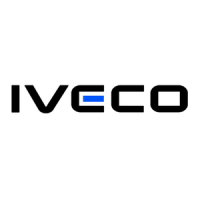Lateral with belt transmission
If large sizes hinder movement transmission from the shafts, the connexion between the engine and the
used machine is done by means of trapezoidal or toothed belts.
Avoid that the driving pulley is flanged directly to the engine because:
■ The lateral stress generated by the belts tension is falls directly onto the crankshaft bearings, which
cannot bear excessive supplementary loads that limit the driving power.
■ The flywheel inertia increases and it may reach values that might add critical torsion speeds in the
engine application area.Thus, it is important to analyse the torsion vibrations carefully.
If the driving pulley must be mounted on the flywheel, check the following:
■ The pulley diameter should not be larger than half the flywheel diameter.
■ Races for 10 mm belts in number maximum of 3; 2 for 13 mm belt.
■ The distance between engine and belt shafts must be reduced to a minimum.
■ Adequate the power absorption to the allowed lateral stress in the engine; also check that the belt
tension matches the maximum tension values indicated by the belt manufacturer.
The dockyard personnel must assess correctly the belt drive, communicating IVECO technical depart-
ments the resulting lateral strain value applied to the engine flywheel.
If two different belt drives are present, mount them, paying attention the lateral loads balance by plac-
ing them in opposite direction.
Summarising, the engine pulley should be mounted with bearing independent form the engine by
means of a cone joint properly attached to the flywheel.
10.3 FRONT PULLEY POWER TAKE-OFF
On the engine shafts
If this alternative is adopted, it is necessary to control that according to its mode, the engine is equipped
with an appropriate pulley to guarantee perfect drive and alignment by interposing an adequate joint.
In some engine models, elastic, toroid Giubo-type joint may be used.When mounting this type of joint,
the attached metallic clamp can only be removed after fastening the bolts that connect it to the flange,
which pre-tenses the rubber element. If this is not observed, the joint will break.
The Giubo-type joint is not adequate and consequently not admitted for cardan joint shaft drive or in
the case of those that allow reduced angles between the engine main shaft and the shaft axes. In this
case, it is necessary to use an intermediate support.
For information on application criteria and instructions to mount the shafts with cardan joints refer to
Section 3.
When installing the driving system take into account the movements of the engine and the driven parts
in the case of installations on elastic suspension.
The maximum power values and torque to be used are normally lower than those of the flywheel,
and they will be able to be later reduced in relation to what is absorbed on the flywheel, if used
simultaneously.
The limit values are indicated in each engine technical information chart.
When an IVECO joint is not being used, the dockyard technical staff will be in charge of finding an
appropriate solution in terms of the driving torque, flexibility, rotational speed and the allowable vibra-
tion or movement, reliability, etc. A flexible torsional joint must be available to decouple the mass dri-
MARCH 2004 AUXILIARY SERVICES
10.102
MARINE ENGINES INSTALLATION

